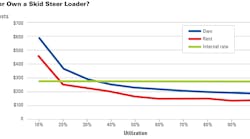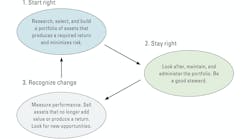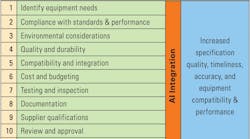As an equipment manager in 2011, you’re probably faced with managing an older fleet than ever before. Your organization and owners aren’t spending the usual dollars to replace old iron, and this economic picture will probably continue in one form or another for many years. Asset managers will have to move the replacement point further out and own equipment longer, which means more life from components and extending the lifecycle.
There are some things we can do:
• Ask operations to take better care of the equipment. Good idea, but usually not in our control.
• Examine specifications to buy more robust iron. Another good idea, but it adds cost today and the benefits come years from now.
• Redefine the maintenance program from “reactive” to a “planned” or a “scheduled” maintenance program. Good start, but not enough.
• Redefine the maintenance program to a “condition-based maintenance” (CBM) program: Bingo! Definitely the best approach.
The idea behind a CBM program is to better examine, better inspect, measure everything possible, and do the preventive maintenance steps to extend component life. If we’re getting 6,000 hours on a pump, what does it take to extend the life to 10,000 hours...with the same uptime? CBM involves filter caddies, improved hose making, heat guns, telematics, used oil analysis, large-particle analysis, and many other high-tech concepts.
This article focuses on managing contamination control—one of the key pieces of CBM.
Our model should be the aircraft industry, with the goal of zero on-shift failures. None of our major equipment should have a catastrophic component failure. According to M.I.T.’s Dr. Rabinowicz, 70 percent of all deterioration is from surface degradation. In other words, 70 percent of all component failures come from corrosion (20 percent) or mechanical wear (50 percent). A contamination-control program directly addresses wear in oil-wetted components, which can bring expensive breakdowns.
Before you get serious about your contamination control program, assign it to someone in authority who has the time and interest to do the job. Expect to spend some significant money on filters, breathers and covers. It could take a year to design and install. Be willing to demand that shop and field procedures be written and followed. This is a top-down program and requires that the senior managers buy into contamination control. Ensure you use vendors who subscribe to this concept. Your dealers are experts at this and can provide good, specific advice.
Let’s examine the pieces of a contamination-control program:
• Training and record keeping;
• Equipment wash facility, which ensures you properly wash equipment before it is moved to your shop;
• General shop attributes include concrete pads at shop entrances, workshop doors, floors, designated storage areas, component stands, workbenches, and other such items;
• General shop practices include securing open lines and covering open components, packaging, storing/disposing of used oil, open containers, airborne dust;
• General shop housekeeping includes cleaning up oil spills, floor cleaning, waste containers;
• Hydraulic hose rebuilding;
• Parts storage;
• Remanufactured parts return includes core returns;
• Bulk fluid storage includes filtration into and after storage tanks, breathers, oil barrel covers, etc.;
• Fueling includes fuel island practices, filler nozzles, PM on vehicles and compartments;
• Lube truck includes fluids entering and exiting truck, breathers, PM on vehicles and compartments;
• Field service includes field repair practices; and
• Fluid cleanliness includes monitoring of fluids, particle count targets, and recommendations.
Implementing a good contamination-control program is not simple or easy, but it’s one necessary step to extend component life. Think about it.




